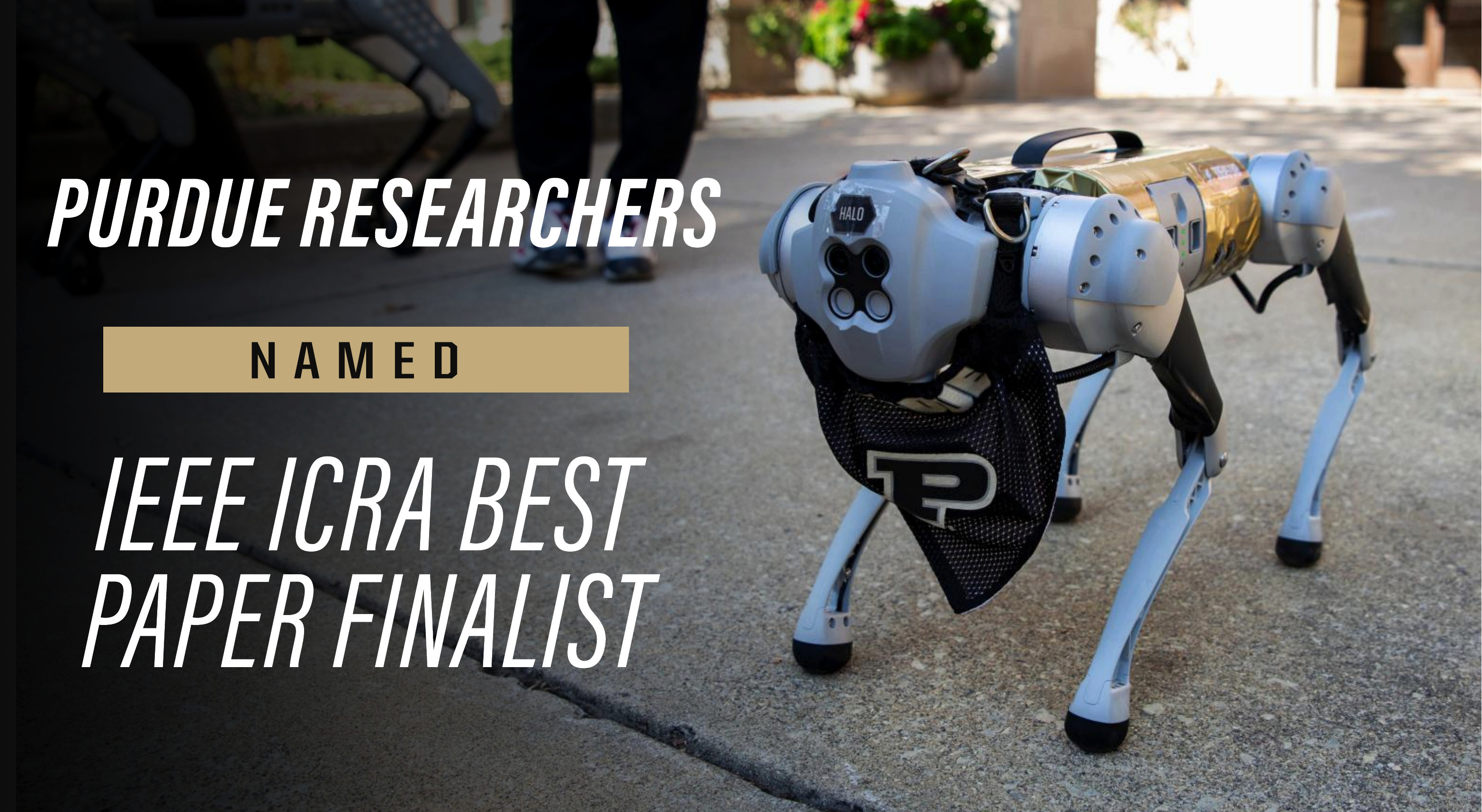Purdue CS researchers earn Best Paper Finalist at 2025 IEEE ICRA
07-25-2025

Halo, a robotic canine at Purdue University.
With advancements in Large Language Models (LLMs), robot agents are becoming increasingly capable of following and executing natural language instructions. However, when dealing with complex instructions, these models often misinterpret or overlook critical constraints, or generate inefficient plans that are impractical in real-world environments. A new AI-powered planning system developed at Purdue University addresses both challenges, enabling robots to generate task plans that are not only safe but also efficient to execute.
Supported by National Science Foundation grants, researchers in Purdue’s Department of Computer Science have developed SELP (Safe Efficient LLM Planner), an advanced system that ensures robot plans follow user commands with high confidence while improving execution time. By combining formal logic with LLMs and domain-specific fine-tuning, SELP brings new levels of reliability and performance to AI-driven task planning for robotics.
The significance of this work has been recognized on the global stage: the SELP paper has been selected as a Best Paper Award Finalist at the 2025 IEEE International Conference on Robotics and Automation (ICRA) and the Best Paper Finalist in the ICRA Planning and Control Track. According to Google Scholar, ICRA ranks as the #1 venue in robotics across all engineering and computer science disciplines, including both journals and conferences, and was the most highly-attended robotics conference. .
The study was conducted by graduate students Yi Wu, who is advised by Lin Tan, Zikang Xiong, Yiran Hu, Shreyash Iyengar, and Nan Jiang; Associate Professor Aniket Bera; the Mary J. Elmore New Frontiers Professor Lin Tan; and the Samuel D. Conte Professor of Computer Science Suresh Jagannathan.
Solving Planning Challenges in Robotics with LLMs and Formal Logic
LLMs are increasingly used to help robots interpret human commands in the role of high-level task planners. Instead of writing code, users can now issue high-level instructions using natural language. For example, a user could ask a household robot to “cook a steak and then wash the pan,” and the LLM planner would seamlessly organize it into a step-by-step plan for cooking followed by cleaning. In navigation scenarios, a user could direct a drone to ”inspect every landmark in the area”, and the LLM planner would generate a sequence of locations for the drone to visit.
Despite their impressive capabilities, LLMs frequently make reasoning errors—especially with long, conditional, or safety-critical instructions. They may misinterpret instructions or generate hallucinated steps that violate the user’s intent. For instance, when instructed to “never enter Zone A after visiting Zone B,” a robot agent using a generic LLM may fail to enforce the rule, undermining trust in autonomous systems.
In addition, LLM planners often struggle to produce time-efficient task plans. Suboptimal or redundant actions can lead to delays, inefficiencies, and poor performance in real-world deployment. These limitations pose significant challenges in time-sensitive or resource-constrained applications.
SELP overcomes these limitations by translating natural language instructions into formal specifications using linear temporal logic. This approach allows robotic planners to verify whether each generated plan step satisfies constraints derived from user instructions, thereby improving correctness and safety. SELP also fine-tunes LLMs on domain-specific robotics tasks, such as drone navigation and robotic manipulation, to improve their ability to generate both safe and efficient plans. SELP significantly enhances LLM planners’ capabilities in handling complex, long-horizon tasks.
Real-World Impact
SELP has broad applicability in both personal and industrial robotics. For individuals, SELP enables natural and trustworthy communication with assistive or household robots, particularly in domains such as eldercare, home support, and service robotics. By converting everyday language into logic-verified, efficient plans, SELP ensures that user preferences and safety requirements are respected.
In mission-critical environments like search-and-rescue, medical delivery, or infrastructure inspection, SELP provides the reliability needed to meet strict operational constraints. For example, a drone operator can instruct a robot to “survey the building but avoid hazardous zones,” and SELP ensures that such rules are strictly enforced with high confidence. This level of dependability reduces the risk of error and enables safer, more effective human-robot collaboration.
A Collaborative BreakthroughSELP is the product of a rare and standout interdisciplinary collaboration, bringing together expertise from robotics, software engineering, and programming languages. Faculty and students from these domains worked closely for over a year to tackle the multifaceted challenge of LLM-based robotic task planning. Purdue’s supportive environment—including strong departmental collaboration, access to high-performance computing resources, and a culture of innovation—was critical to the project’s success.
You can access the abstract and more videos here.
About the Department of Computer Science at Purdue University
Founded in 1962, the Department of Computer Science was created to be an innovative base of knowledge in the emerging field of computing as the first degree-awarding program in the United States. The department continues to advance the computer science industry through research. U.S. News & World Report ranks the department No. 8 in computer engineering and No. 16 overall in undergraduate and graduate computer science. Additionally, the program is ranked No. 6 in cybersecurity, No. 8 in software engineering, No. 13 in systems, No. 15 in programming languages and data analytics, and No. 18 in theory. Graduates of the program are able to solve complex and challenging problems in many fields. Our consistent success in an ever-changing landscape is reflected in the record undergraduate enrollment, increased faculty hiring, innovative research projects, and the creation of new academic programs. The increasing centrality of computer science in society, academic disciplines and new research activities — centered around foundations and applications of artificial intelligence and machine learning, such as natural language processing, human computer interaction, vision, and robotics, as well as systems and security — are the future focus of the department. Learn more at cs.purdue.edu.